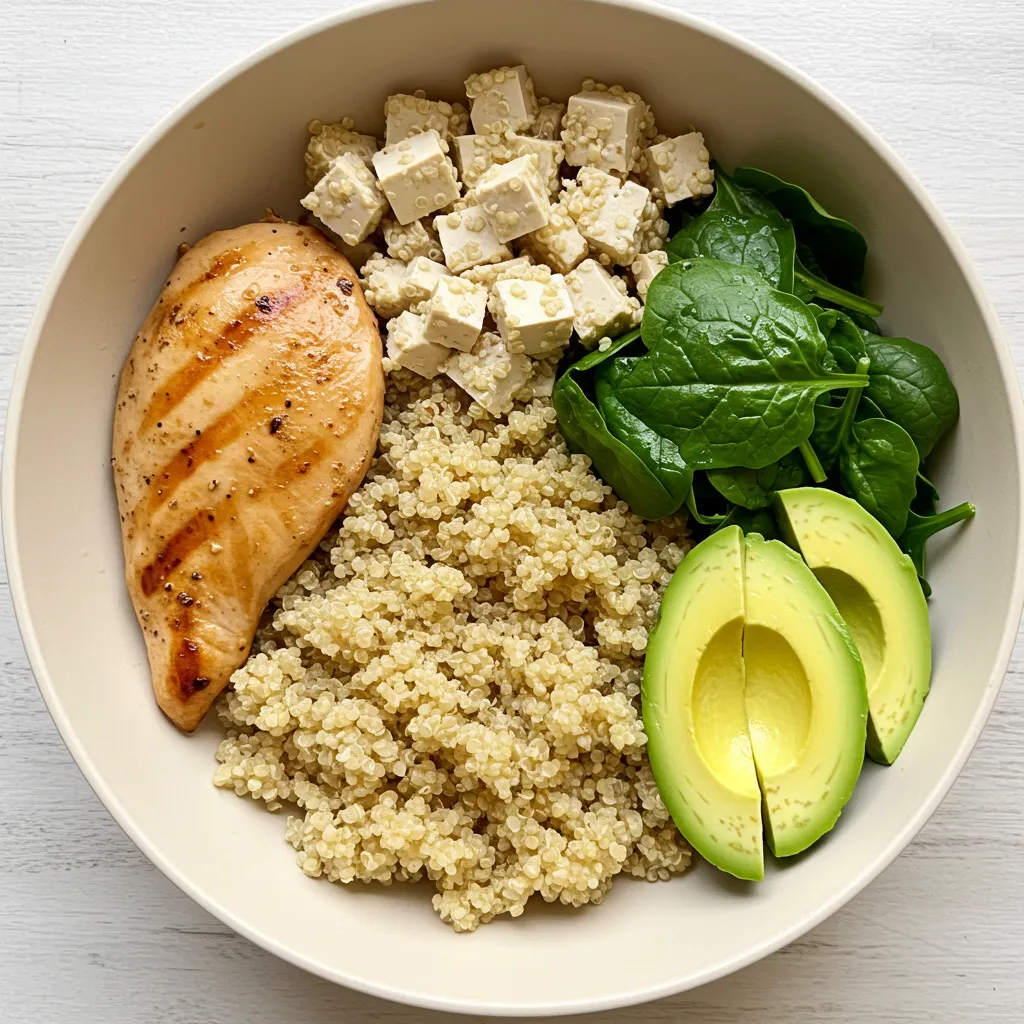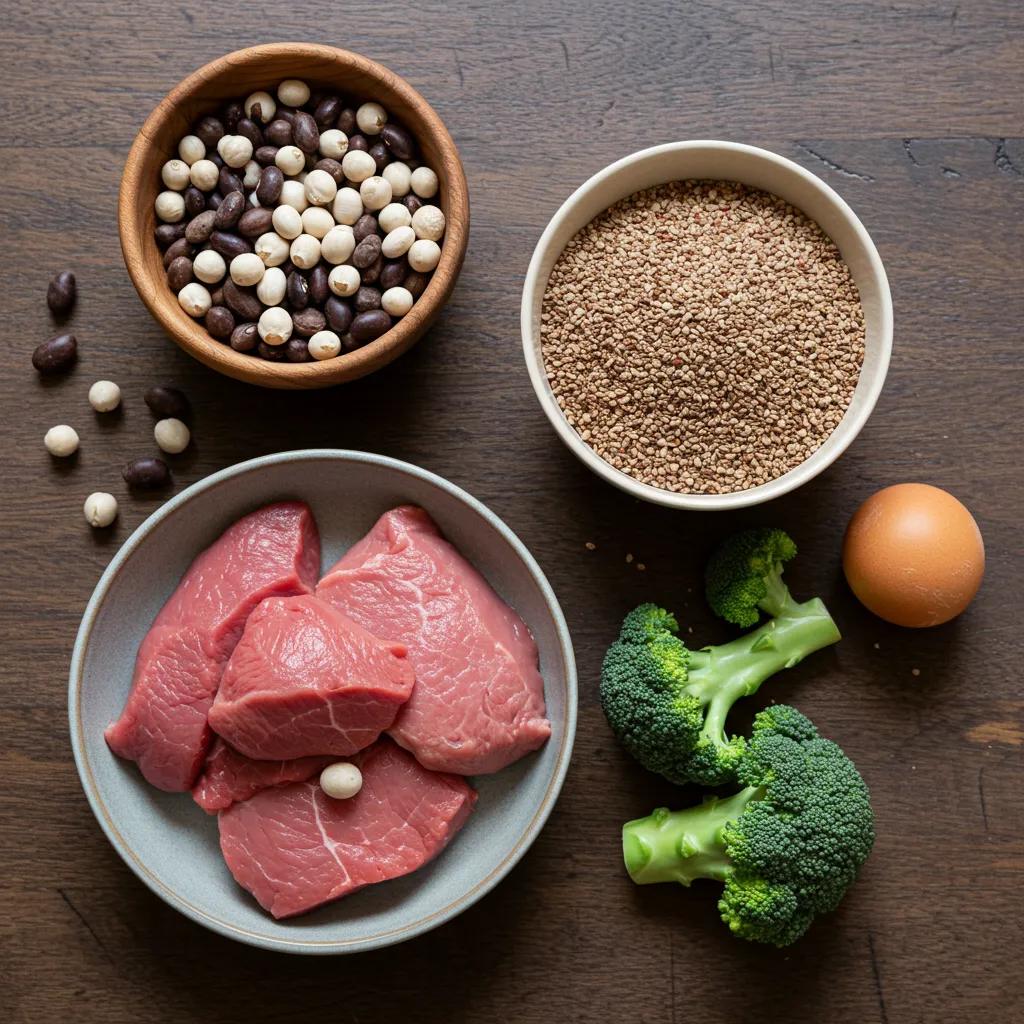💪💪 Want to recover faster after a workout? The secret might be in what you eat.
Clean protein supports muscle repair, reduces soreness, and boosts your energy naturally 🌿.
It comes from whole foods like lean meats, legumes, and plant-based sources—not processed powders or bars.
In this post, you’ll learn the benefits of clean protein, get a simple recipe, and smart recovery tips 🍽️.
Let’s fuel your body the clean and powerful way! 🚀
💪 Health Benefits of Clean Protein for Muscle Recovery
🛠️ Faster Muscle Repair and Reduced Inflammation
After intense physical activity, your muscles experience microtears. To repair these efficiently, your body needs essential amino acids. Clean protein, found in foods like wild salmon, eggs, or quinoa, provides these nutrients in a natural and digestible form.
These amino acids are crucial for rebuilding damaged tissue and supporting full muscle recovery. When you rely on clean sources instead of processed options, your body absorbs what it needs—without added stress from artificial ingredients.
Furthermore, many clean proteins sources contain anti-inflammatory compounds. For example, omega-3s in fish or antioxidants in legumes can help reduce inflammation throughout the body. This is especially beneficial for athletes or active individuals, as it minimizes joint discomfort and speeds up recovery time.
As a result, people who prioritize clean, whole-food protein sources often experience less soreness and improved performance during their next workout.
🏋️ Supports Lean Muscle Growth and Strength
Muscle growth depends on a process called muscle protein synthesis (MPS). This process occurs when your body repairs and builds new muscle fibers after physical exertion. Clean proteins provide the right building blocks for this, ensuring your muscles develop without added fat.
Unlike heavily processed protein bars or powders, whole food sources such as grass-fed beef, chicken breast, or tofu deliver amino acids in their most natural form. These foods support strength gains while maintaining overall health.
Additionally, clean protein allows your body to build lean muscle mass without bloating or digestive issues, which are often linked to synthetic supplements. This makes it easier to stay consistent with training and nutrition.
By choosing whole, minimally processed options, you’re not just supporting muscle development—you’re promoting long-term wellness and balance.
⚡ Boosts Overall Energy and Immune Function
Clean protein is more than muscle fuel—it’s vital for overall health. Foods like cottage cheese, pumpkin seeds, and pasture-raised poultry are nutrient-dense. They provide essential vitamins, minerals, and healthy fats along with protein.
This nutrient density boosts sustained energy. Unlike quick-fix snacks loaded with sugar, clean protein helps stabilize blood sugar levels. As a result, you feel more energized and focused throughout your day.
Moreover, supports immune function by contributing to the repair and regeneration of cells. Your body uses protein to create antibodies, enzymes, and other immune defenders. When you stay active, your immune system works harder, so proper protein intake is essential.
Incorporating clean protein into every meal helps keep your body strong, energized, and resilient—no matter how busy your lifestyle.
💡A Clean Protein Recipe for Muscle Recovery
🥗 Ingredients for a High-Quality Protein Meal
This easy recipe for muscle recovery packs a powerful nutritional punch. It includes high-quality, whole food ingredients that fuel your body.
What you’ll need:
- 4 oz organic grilled chicken breast (or tofu for a plant-based option) 🍗
- ½ cup cooked quinoa 🍚
- 1 cup fresh spinach leaves 🥬
- 1 tsp olive oil + juice of ½ lemon 🍋
- Optional: ¼ sliced avocado for healthy fats 🥑
Each ingredient supports energy, digestion, and muscle repair without added preservatives or artificial ingredients.
👨🍳 Simple Preparation Steps (Under 20 Minutes)
This clean protein bowl is perfect for busy days. It’s quick, satisfying, and great for post-workout meals.
- Grill the chicken or tofu until fully cooked (about 6–8 minutes per side).
- Cook quinoa according to package instructions—usually about 12–15 minutes.
- Toss the spinach, olive oil, and lemon juice in a bowl.
- Add the cooked protein and quinoa on top. Mix gently.
- Add avocado slices if desired. Serve warm or chilled.
That’s it—fresh, fast, and full of clean fuel!

🥗 Nutritional Value (per serving)
- Calories: ~450 kcal
- Protein: ~38 g
- Carbohydrates: ~24 g
- Fiber: ~6 g
- Healthy Fats: ~20 g
- Sugar: ~2 g
- Sodium: ~250 mg
Quick Nutrition Breakdown by Ingredient:
| Ingredient | Calories | Protein | Carbs | Fats | Fiber |
| 4 oz grilled chicken breast | ~140 kcal | ~26 g | 0 g | ~3 g | 0 g |
| ½ cup cooked quinoa | ~110 kcal | ~4 g | ~20 g | ~2 g | ~2.5 g |
| 1 cup fresh spinach leaves | ~7 kcal | ~1 g | ~1 g | ~0 g | ~0.7 g |
| 1 tsp olive oil | ~40 kcal | 0 g | 0 g | ~4.5 g | 0 g |
| ¼ sliced avocado (optional) | ~55 kcal | ~1 g | ~3 g | ~5 g | ~2.5 g |
Notes:
- Without avocado, the bowl is about 395 kcal with ~15 g of fats.
- With avocado, you boost healthy fats and fiber intake.
- It’s a great balance of lean protein, complex carbohydrates, and good fats.
💪 Why This Recipe Supports Recovery
This balanced clean protein recipe delivers all essential amino acids. Quinoa and chicken offer complete protein profiles.
Healthy fats from olive oil and avocado aid in nutrient absorption. Meanwhile, spinach adds iron and antioxidants for energy.
Together, these ingredients help reduce inflammation, rebuild muscle, and replenish energy stores post-workout.
As a result, your body recovers faster and performs better the next day.
Recipes – Related content:
- Ground Elk Recipe: How to Cook the Perfect Lean Protein
- Keto Side Dishes You Need to Try – Quick, Tasty, and Low-Carb
- Cream Wheat vs. Regular Wheat: Which is Better for Your Health?
For more Clean Protein Recipes:
- Clean Proteins recipe of the week: Smokey sweet potato boats
- Clean Proteins recipe of the week: Hot fried maitake chick’n
💪 Best Clean Protein Sources for Athletes and Fitness Lovers
🍖 Animal-Based Clean Proteins
Athletes and fitness lovers often rely on animal-based protein sources for muscle growth and recovery. These foods are rich in complete amino acid profiles, which are essential for rebuilding tissue.
Great options include grass-fed beef, wild-caught salmon, organic turkey, and cage-free eggs. Not only do they provide clean protein, but they also contain beneficial nutrients like iron, B12, and omega-3s.
To maximize benefits, choose ethically sourced, hormone-free meat and eggs. These options are cleaner, more sustainable, and support overall wellness. Additionally, shopping local or from trusted farms ensures transparency in sourcing.
🌱 Plant-Based Clean Protein Options
For plant-based eaters, there are many clean protein alternatives that support active lifestyles. Lentils, chickpeas, tofu, and quinoa are all excellent sources of plant protein. They are high in fiber, which also aids digestion.
Another great option is pea protein isolate. It’s allergen-friendly, easy to digest, and packed with essential amino acids. This makes it a smart choice for people avoiding soy or dairy.
Moreover, combining different plant proteins ensures you’re getting all nine essential amino acids. As a result, you can still build lean muscle effectively on a plant-based diet.
🥤 Clean Protein Powders and Supplements
When convenience matters, clean protein powders can help you meet your fitness goals. Opt for whey protein isolate or brown rice protein—both are effective and easy on digestion.
However, it’s important to check labels. Avoid powders with added sugars, artificial flavors, and unverified ingredients. These can cause inflammation and hinder recovery.
Look for third-party certifications like NSF or Informed-Sport. They ensure your supplement meets safety standards and is free of banned substances.
In summary, whether you’re grabbing a shake or cooking a full meal, clean protein supports performance the smart way.
When and How to Eat Clean Protein for Recovery
⏱️ Optimal Timing After Workouts
Post-workout nutrition plays a big role in recovery. The best time to eat clean protein is within 30–60 minutes after your workout. This window helps maximize muscle repair and growth.
For even better results, pair your protein with healthy carbs. This combination replenishes glycogen and supports energy levels. For example, try grilled chicken with brown rice or a banana with almond butter.
Although supplements can help in a pinch, real food is the better option. Whole foods offer more nutrients and are easier on digestion compared to processed protein powders.
⚖️ Portion Sizes and Frequency
Getting the right amount of clean protein matters. Most active adults need 20–30 grams of protein per meal to support recovery. That’s about the amount in a piece of salmon or a cup of lentils.
Spread your intake across 3–5 meals daily. This helps maintain muscle protein synthesis throughout the day and supports consistent energy.
Remember, your clean protein needs may differ from total protein intake. Focus on quality—opt for unprocessed, whole-food sources whenever possible.
🍽️ Sample Post-Workout Clean Protein Meals
Need quick meal ideas? These post-workout options are delicious, nutrient-packed, and easy to prepare:
- Greek yogurt with fresh berries and chia seeds
- Baked salmon with sweet potatoes and steamed broccoli
- A smoothie with clean protein powder, almond milk, banana, and oats
These meals deliver protein, carbs, and healthy fats—all essential for a full recovery and steady progress.
❌ Clean Protein Myths and Mistakes to Avoid
🏋️♀️ Clean Protein Is Only for Bodybuilders
One of the biggest clean protein myths is that it’s only for people who lift heavy weights. However, that’s not the case. In fact, everyone—from athletes to office workers—can benefit from eating clean protein regularly.
It supports muscle health, improves energy levels, and helps maintain a healthy weight. Additionally, clean protein boosts your immune system and supports cell repair, even if you’re not hitting the gym daily.
Therefore, protein isn’t just for bodybuilders—it’s essential for overall health and daily function.
⚠️ More Protein = Better Results (Not Always)
Another common nutrition mistake is thinking that more protein always leads to better results. However, that belief can backfire.
While protein is important, too much can cause issues like poor digestion and kidney stress. Furthermore, it won’t lead to extra muscle gain unless paired with proper training.
Instead, focus on balance. For optimal results, combine clean protein with complex carbs and healthy fats. This way, your body absorbs nutrients more efficiently and performs at its best.
🔍 All Protein Powders Are Clean
Some people assume all protein powders are clean and healthy. Yet, this is one of the most misleading clean protein myths.
Many powders contain hidden sugars, artificial flavors, and chemical additives. As a result, they may harm your health rather than support recovery.
To avoid this, read ingredient labels carefully. Choose options with minimal, recognizable ingredients. Also, look for third-party certifications like NSF or Informed-Sport to ensure purity.
Ultimately, not all supplements are created equal—so stay informed to make the best choice.
Conclusion
Clean protein is a powerful tool for boosting your recovery, strength, and overall health. 🏋️♂️ By choosing nutrient-rich foods like lean meats, legumes, and plant-based options, you fuel your body with what it truly needs to perform and heal naturally.
Whether you’re whipping up a simple chicken and quinoa bowl or grabbing a clean protein smoothie, every smart choice adds up. Transitioning to whole, minimally processed foods helps you recover faster, feel more energized, and stay strong in the long run.
Skip the artificial powders and focus on real, clean protein sources instead. 🌱 Your muscles, mind, and immune system will thank you! Ready to take your recovery to the next level? Start by adding one clean protein meal to your routine this week—you’ll feel the difference! 💪

